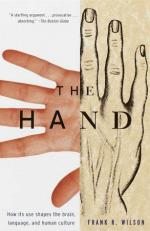
|
| Name: _________________________ | Period: ___________________ |
This test consists of 5 short answer questions, 10 short essay questions, and 1 (of 3) essay topics.
Short Answer Questions
1. Who is Robin Dunbar?
2. What is the strength of a climber's grip on a rock face?
3. How many muscles that are attached to the thumb enable it to do its work?
4. How many key strokes per second can a pianist reach?
5. What is the other main reason the author writes this book on the hand?
Short Essay Questions
1. How were the ape and human hands compared anatomically until recently?
2. Who is David and how is he able to succeed at wrestling despite not being very strong?
3. Who is Robin Dunbar and what does he propose?
4. What aspects of the human capacity for passionate, creative work does Wilson illustrate?
5. How is the arm different from the leg in how it is attached to the body, and which parts of the upper body corresponds to the "folding crane"?
6. Explain the crane metaphor Wilson uses.
7. How did Duchenne demonstrate the physiology of movement?
8. What does Wilson say about our hands and feet as we are about to waken and right after?
9. According to Wilson, what are the two problem-solving strategies that stand out?
10. Who is Merlin Donald and what does he propose?
Essay Topics
Write an essay for ONE of the following topics:
Essay Topic 1
Through the ages of human history Wilson explores cultural transformation of human paths and posits the "permanent immaturity" of a human brain. Wilson's underlying thesis is that people are born resourceful. Over time and experience, they adapt and evolve to become skillful and thoughtful.
1. Explain, in detail what is meant by "permanent immaturity" of a human brain. Use examples from the text to support your answer.
2. Discuss two ways in which humans have adapted to their environment. Use examples from the text to support your answer.
3. Explain how becoming more skillful and thoughtful is related to evolution. Use examples from the text to support your answer.
Essay Topic 2
In order for hominids to expand their range into habitats beyond the jungle, they required continuing brain evolution. The expansion of territory by hominids took group cooperation for survival. A professor of biology from the University of Liverpool named Robin Dunbar proposes a theory of brain growth, language and intelligence to correlate neocortex, brain size, with a stable group or tribe.
1. Explain how greater intelligence enabled hominids to leave the jungle. Use examples from the text to support your answer.
2. Explain, in depth, why cooperation among hominids would be an important aspect of survival. Use examples from the text to support your answer.
3. Discuss ways in which cooperation and social living might increase the brain size or intelligence of hominids. Use examples from the text to support your answer.
Essay Topic 3
Discuss the following:
1. A puzzling consideration for the author is the hand's ability to be adept at rock-climbing and piano-playing. What do you think is meant by this statement? Use examples from The Hand to support your answer.
2. The human hand is a tool that functions at a wide variety and range of speed and strength. Use examples from the text to support your answer.
3. The hand function clinician John Napier identifies the terms "power grip" and "precision grip" by defining "prehensile" and "non-prehensile" movement. Explain the terms in the above sentence. Use examples from the text to support your answer.
|
This section contains 1,062 words (approx. 4 pages at 300 words per page) |

|




